
A cable car is a type of cable railway used for mass transit in which rail cars are hauled by a continuously moving cable running at a constant speed. Individual cars stop and start by releasing and gripping this cable as required. Cable cars are distinct from funiculars, where the cars are permanently attached to the cable.

A funicular is a type of cable railway system that connects points along a railway track laid on a steep slope. The system is characterized by two counterbalanced carriages permanently attached to opposite ends of a haulage cable, which is looped over a pulley at the upper end of the track. The result of such a configuration is that the two carriages move synchronously: as one ascends, the other descends at an equal speed. This feature distinguishes funiculars from inclined elevators, which have a single car that is hauled uphill.
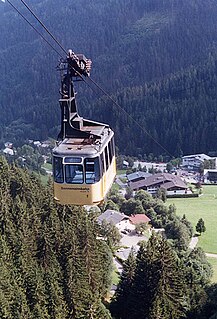
Cable transport is a broad class of transport modes that have cables. They transport passengers and goods, often in vehicles called cable cars. The cable may be driven or passive, and items may be moved by pulling, sliding, sailing, or by drives within the object being moved on cableways. The use of pulleys and balancing of loads moving up and down are common elements of cable transport. They are often used in mountainous areas where cable haulage can overcome large differences in elevation.

Avalon is the only incorporated city on Santa Catalina Island, in the California Channel Islands, and the southernmost city in Los Angeles County. The city is a resort community with the waterfront dominated by tourism-oriented businesses. The older parts of the town on the valley floor consist primarily of small houses and two and three-story buildings in various traditional architectural styles.

Angels Flight is a landmark and historic 2 ft 6 in narrow gauge funicular railway in the Bunker Hill district of Downtown Los Angeles, California. It has two funicular cars, named Olivet and Sinai, that run in opposite directions on a shared cable. The tracks cover a distance of 298 feet (91 m) over a vertical gain of 96 feet (29 m).
A gravity railroad or gravity railway is a railroad on a slope that allows cars carrying minerals or passengers to coast down the slope by the force of gravity alone. The speed of the cars is controlled by a braking mechanism on one or more cars on the train. The cars are then hauled back up the slope using animal power, a locomotive or a stationary engine and a cable, a chain or one or more wide, flat iron bands. A much later example in California used 4 ft 8+1⁄2 instandard gauge steam engines to pull gravity cars back to the summit of Mt. Tamalpais.

A cable railway is a railway that uses a cable, rope or chain to haul trains. It is a specific type of cable transportation.

The Mount Lowe Railway was the third in a series of scenic mountain railroads in the United States created as a tourist attraction on Echo Mountain and Mount Lowe, north of Los Angeles, California. The railway, originally incorporated by Thaddeus S. C. Lowe as the Pasadena and Mt. Wilson Railroad Co., existed from 1893 until its official abandonment in 1938, and was the only scenic mountain, electric traction railroad ever built in the United States. Lowe's partner and engineer was David J. Macpherson, a civil engineer graduate of Cornell University. The Mount Lowe Railway was a fulfillment of 19th century Pasadenans' desire to have a scenic mountain railroad to the crest of the San Gabriel Mountains.

Two Harbors, colloquially known as "The Isthmus", is a small unincorporated community island village on the island of Santa Catalina Island, California, with a population of 298. It is the second center of population on the island, besides the city of Avalon. It is mainly a resort village. It has only one restaurant, one hotel and one general store. The village has about 150 permanent residents who live on the isthmus year-round. One notable feature was the one-room schoolhouse which closed in 2014.
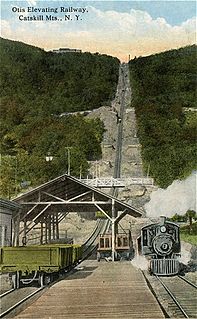
The Otis Elevating Railway was a 3 ft narrow gauge cable funicular railroad leading to the Catskill Mountain House in Palenville, New York. For the first 64 years of its existence, the Catskill Mountain House was accessible only by a long stagecoach from Catskill Landing on the Hudson. Faced with increased competition from the Hotel Kaaterskill, Charles Beach hired the Otis Elevator Company to build a cable funicular railroad straight up the Great Wall of Manitou. Opening on August 7, 1892, the line measured 7,000 ft (2,134 m) long with a rise of 1,630 ft (497 m), a maximum grade of 34%, and an average grade of 12%. In 1904, the line was shortened and the lower trestle eliminated.
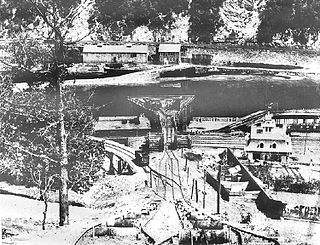
The Mauch Chunk and Summit Railroad was a coal-hauling railroad in the mountains of Pennsylvania that operated between 1828 and 1932. It was the first operational railway, in the United States, of any substantial length to carry paying passengers.
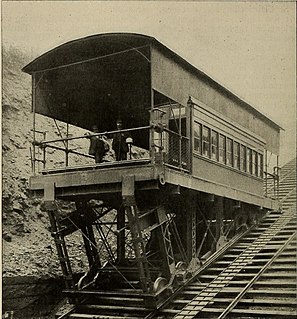
The Castle Shannon Incline was a funicular railroad in Pittsburgh, Pennsylvania. It was originally part of the Pittsburgh and Castle Shannon Railroad route to the suburb of Castle Shannon. It replaced an earlier incline dating to 1825 that brought coal down from a mine in Mount Washington.

Santa Catalina Island is a rocky island off the coast of Southern California in the Gulf of Santa Catalina. The island name is often shortened to Catalina Island or just Catalina. The island is 22 mi (35 km) long and 8 mi (13 km) across at its greatest width. The island is located about 29 mi (47 km) south-southwest of Long Beach, California. The highest point on the island is Mount Orizaba. Geologically, Santa Catalina is part of the Channel Islands of California archipelago and is the easternmost of the Channel Islands. Politically, Catalina Island is part of Los Angeles County in District 4. Most of the land on the island is unincorporated.
The Westgate Line was a suburban route operated by the Pacific Electric Railway from 1911 to 1940. This line was one of four lines connecting Downtown Los Angeles and Santa Monica that did not run through Hollywood. The line is notable for taking a circuitous route towards its end, along San Vicente Boulevard, mainly because it was built to encourage construction of new homes near Pacific Palisades.

Ashley Planes was a historic freight cable railroad situated along three separately powered inclined plane sections located between Ashley, Pennsylvania at the foot, and via the Solomon cutting the yard in Mountain Top over 1,000 feet (300 m) above and initially built between 1837-38 by Lehigh Coal & Navigation Company's subsidiary Lehigh and Susquehanna Railroad (L&S). One result of the 1837 updates of omnibus transportation bills called the Main Line of Public Works (1824), the legislation was undertaken with an eye to enhance and better connect eastern settlement's business interests with newer mid-western territories rapidly undergoing population explosions in the Pre-Civil War era. But those manufactories needed a source of heat, and the Northern Pennsylvania Coal Region was barely connected to eastern markets except by pack mule, or only through long and arduous routes down the Susquehanna then overland to Philadelphia.
The Venice Short Line was a Pacific Electric interurban railway line in Los Angeles which traveled from downtown Los Angeles to Venice, Ocean Park, and Santa Monica via Venice Boulevard.

Sumner Spaulding (1892–1952) was an American architect and city planner. He is best known for designing the Harold Lloyd Estate, a.k.a. Greenacres, in Beverly Hills, California, the Catalina Casino in Avalon on Santa Catalina Island, California, and the Malaga Cove Plaza in Palos Verdes Estates, California.
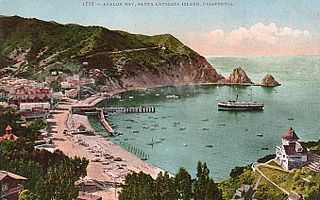
The history of human activity on Santa Catalina Island, California begins with the Native Americans who called the island Pimugna or Pimu and referred to themselves as Pimugnans or Pimuvit. The first Europeans to arrive on Catalina claimed it for the Spanish Empire. Over the years, territorial claims to the island transferred to Mexico and then to the United States. During this time, the island was sporadically used for smuggling, otter hunting, and gold-digging. Catalina was successfully developed into a tourist destination by chewing gum magnate William Wrigley, Jr. beginning in the 1920s, with most of the activity centered around the only incorporated city of Avalon, California. Since the 1970s, most of the island has been administered by the Catalina Island Conservancy.

The Penn Incline, also known as the 17th Street Incline, was a funicular railroad that ran between the Strip and Hill districts in Pittsburgh, Pennsylvania. It operated from 1884 to 1953.


















